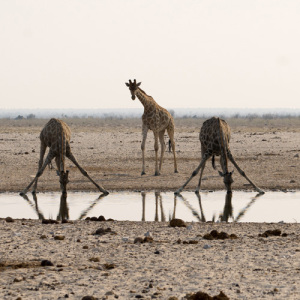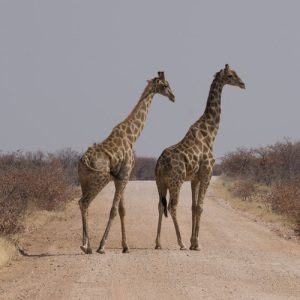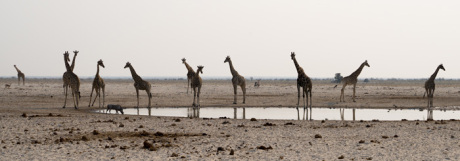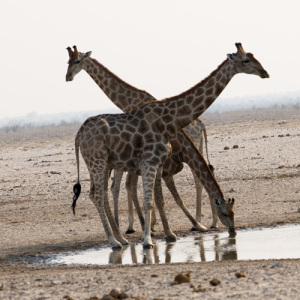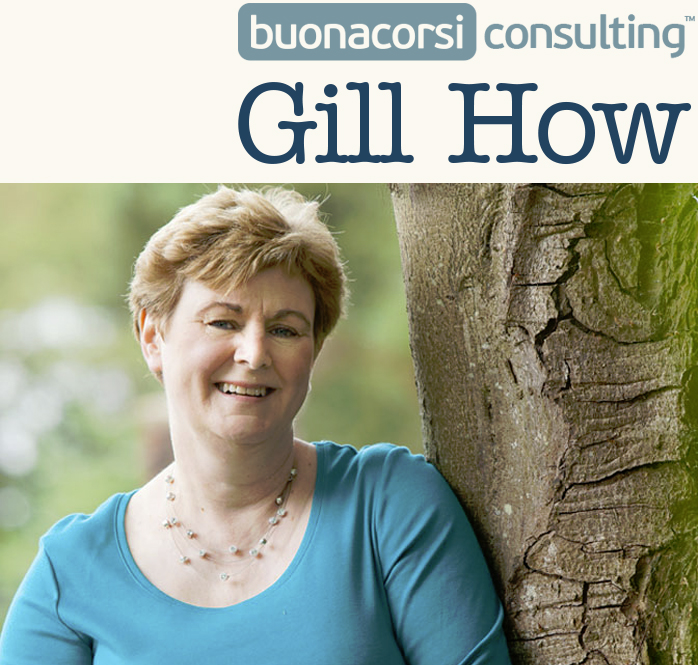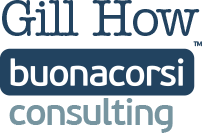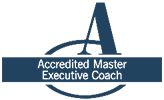We saw over a dozen giraffes drinking at the Ozonjutiji m’Bari waterhole in Western Etosha in Namibia in August this year. It was nearing dusk and it was magical to watch them, to observe how they took turns to drink, with those standing keeping a look out for predators. A giraffe is vulnerable when it splays its forelegs and bends its knees to get its long neck close enough to the water to drink.
Giraffes are usually found in groups. We are told that the composition of these groups tends to be open and ever changing, and that groups can change members as often as every few hours! This was consistent with our drive through Etosha, where we saw group after group of giraffes moving across the landscape.
I got thinking. It really did seem that the giraffes were looking out for and taking care of each other. Does this apply to how we are, in the workplace, in groups or teams?
Working in a team or group usually allows us to achieve more than working on our own. We can combine expertise, tackle a larger problem or increase the scope of the endeavour. One person could not, for example, submit a complex multi skilled sales tender in a tight timescale or carry out complex medical surgery on patients in hospital on their own. Humans seem to be motivated to achieve more, invent more and find out more by working together.
Working with other people is tough though, isn’t it?
It keeps team facilitators like me busy, helping groups and teams to communicate, co-operate and collaborate. I can help a team pay attention to how they are with each other as well as complete the task. Why do this? Because it can be hard for us to see the best in each other when tempers are frayed, pressure is mounting and stress is high. And this is often the territory, the threat, the predator, when we are working together to achieve significant goals. In these conditions many of us drop back to blame, silos or protecting our own backs. Then, in my experience, there are two main avenues for what happens next:
- Option 1 – We achieve the task – meet the goal – but damage, sometimes irretrievably, the relationships
- Option 2 – We fail with both the task and the relationship.
A clear case of where many if not most of us would wish for “Option 3”!
So how can we stay together when the going is tough? What might“Option 3”, for dealing with these modern day, human predators, be? Here are three pointers:
1 Remember the Goal
For the giraffes, it’s likely that safety is the number one goal. Your group or team may have an awesome goal, such as eliminating malaria from the world (The Bill and Melinda Gates Foundation), reducing the threat of terrorism for everyone (here’s an interesting talk by the MI5 Director General), running high performance railway operations or enabling excellent academic outcomes for your learners.
Question: What is the awesome goal that glues your team or group together – that everyone wants to sign up to, and that everyone benefits from?
How can you reiterate it, embed it, make it even more alive and relevant for each and every person, every day?
2 Embrace Vulnerability to Enable Creativity
The giraffes remember at all times their vulnerability to predators such as lion and leopard, and work together to protect themselves. The work of Brene Brown defines vulnerability for us as uncertainty, risk and emotional exposure. This is something we can experience in spades in groups or teams!
Her work suggests that vulnerability is the birthplace of love, belonging, joy, courage, and creativity. It’s the source of hope, empathy, accountability and authenticity.
In our context of modern day, human predators – stress, pressure and fear of failure – we need more than ever to get the best out of our people. We need the synergy of the team and the full accomplishment of the group. For this we need the fruits of our vulnerability.
Question: How can you create a climate where the people in your team or group can be vulnerable and offer their creative best work? Can you succeed with your awesome goal without it?
3 Tiny Steps in Conversation
Giraffes communicate with each other more than is obvious to many of us, including non-verbally and infrasound (frequencies too low for humans to hear). I find it amusing that a giraffe “group” is defined withinWikipedia as “a collection of individuals that are less than a kilometre apart and moving in the same general direction”.
Often the tiniest action we can take in our team or group is to let others know what we are thinking or feeling. It can change the shape, track and outcome of a conversation straight away.
If we genuinely believe that authentic conversation can help the group change direction, keep us on track and move in the same direction, as a series of tiny steps, this is a “no brainer”, even if does seem a risk. Rather than plan for (and talk yourself out of) massive courageous conversation, why not start small, allow others to join in, and influence each other on the desired direction?
Question: How can you encourage, role model and reward the tiniest steps in authentic conversation – the sort that draws everyone towards common understanding? Understanding, that is, of achieving your goal.
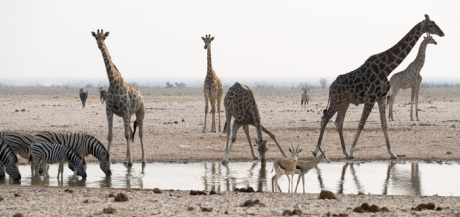
Giraffes, zebra and other animals at the waterhole, observing, drinking and communicating with each other
Three pointers to help you achieve “Option 3”
- Remembering the goal,
- Embracing vulnerability to enable creativity
- Tiny steps in conversation
How much can these three things help you keep your team or group “less than a kilometre apart and moving in the same general direction?”
Is “Option 3”, as a way of managing the modern day predators – fear of failure, stress, pressure, blame, silos or protecting our own backs (name your own!) – attractive to you?
If the behaviour of giraffes in a group has stimulated your thinking, and you would like to explore how “Option 3” can keep your people pulling together to deliver your goal, then do email and get in touch.
I’d love to work with you on a complicated, difficult and “worth it” type project ideally with an outrageously ambitious goal. And if your work is pioneering, or it hasn’t been done before, that’s better still!
Blog Summary – Giraffes benefit from drinking in a group. By sticking together and sharing their vulnerability, they achieve their goal of safety. Can I help your group look out for each other, to support the accomplishment of your awesome goal?
Photo credits: Martin How

